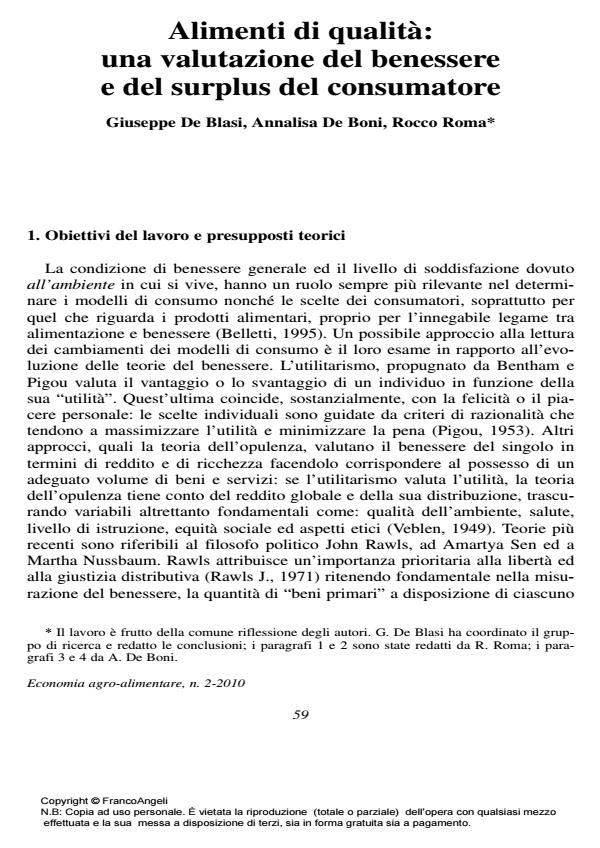High quality foods: a consumer’s wellbeing and surplus evaluation
Journal title ECONOMIA AGRO-ALIMENTARE
Author/s Giuseppe De Blasi, Annalisa De Boni, Rocco Roma
Publishing Year 2011 Issue 2010/2 Language Italian
Pages 15 P. 59-73 File size 823 KB
DOI 10.3280/ECAG2010-002005
DOI is like a bar code for intellectual property: to have more infomation
click here
Below, you can see the article first page
If you want to buy this article in PDF format, you can do it, following the instructions to buy download credits

FrancoAngeli is member of Publishers International Linking Association, Inc (PILA), a not-for-profit association which run the CrossRef service enabling links to and from online scholarly content.
The widespread wellbeing and the fulfillment for one’s own standard of living play a role more and more relevant to define consumer’s behavior in particular with regard to food consumption. Recently John Rawls, Amartya Sen and Martha Nussbaum overcoming conventional wellbeing theory approaches, putting together traditional wealth indicators (income, expenditure, property) with the evaluation of situations and experiences that people consider worthy of value. In developed countries food requirements are nearly completely satisfy and new choice models leads consumers to evaluate food, not only in relation to nutritional and health aspects, but, oftener and oftener, to: consumption opportunities, easiness to use, health contents, region of origin. The aim of this work is to evaluate the effects on consumer’s behavior of individual wellbeing level and pleasure for environment in which they live. First step of survey had the aim to evaluate consumer’s wellbeing level by traditional income indicators and data about consumers’ feeling of their own welfare. A sample of charger of family purchases has been selected and asked about their own satisfaction for economy, offices effectiveness, law and order, welfare, state education, spare time availability, environmental conditions. Afterward has been asked the willingness to pay (wtp) more than the market price for four group of food. The first group included "basic" foods, the others the "high quality" products such as "protected designation of origin", "ready to eat" and "health" foods. Each product demands curve has been drown by regression analysis and consumer surplus has been calculated as the difference between the higher observed consumer’s wtp and the amount he actually paid. The results of survey pointed out a positive relationship between consumer wellbeing and preferences for high quality foods. Happier consumer seem to perceive better than the others food quality features. A high wellbeing standard and a great fulfillment of one’s own life promote quality food demand more than income level. Every act to support and promote quality food demand will be more efficient in framework in which consumer have best standard of life.
Keywords: Foods consumer’s behavior, willingness to pay, demands curve
Jel codes: D1, D4, D6
Giuseppe De Blasi, Annalisa De Boni, Rocco Roma, Alimenti di qualità: una valutazione del benessere e del surplus del consumatore in "ECONOMIA AGRO-ALIMENTARE" 2/2010, pp 59-73, DOI: 10.3280/ECAG2010-002005